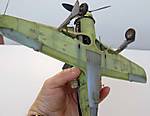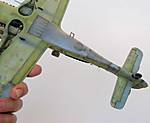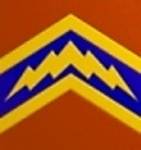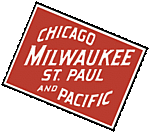1⁄35Fw 190D-9 Part 1
11
Comments
HINDSIGHT IS ALWAYS "20-20"
Before I actually started work on the kit, I purchased soft cover two reference books: the Squadron/Signal Publication Number 10, the Walk Around for the FW 190 D and the Marian Krzyzan Aircraft Monograph Number 6 on the FW 190 D / Ta 152. IMO, these two references would be invaluable for someone wanting to build a model of the Focke Wulf 190 D. Then I bought the old Hasegawa 1:32nd FW 190 D-9 kit and also the Verlinden detail set for the kit. The Revell Dora kit came with a Jumo 213 engine, as most all of those 1:32nd single engine fighters released by RevellUSA in the 1970s had engines in those kits.Over the last ten years or so, I have build and painted most all my model kits and figures for IPMS contests around the American Heartland. I don't seem to be interested in building a model straight out of the box (OOB, in future). So for contest models, I usually try to do something that hasn't been seen in a while or is esoteric subject matter. So I usually do a lot of extra work beyond OOB category parameters in an attempt to increase my odds of winning. I will say candidly, that this kind of thinking has been known to backfire on me. And in terms of competing with this model in two of the IPMS National Conventions and in one IPMS Regional event, it did backfire. (More on that in the other parts of this series.) So, it was my idea to cut away the kit nose, side/top engine cowlings, use the kit engine as a place to start and improve on, and use my old Mattel Vacuform toy to mold new thinner engine cowls and show them in the open position. I would scratch-build the additional hoses and coolant/oil tanks to make the Dora engine compartment more eyecatching.
I examined closely both the Revell and the Hasegawa kit parts to see what kit offered the best airframe for what I intended to do. Also, it would have been very difficult to get the Revell kit engine to fit into the front of the Hasegawa fuselage. Although there are raised rivets on the Revell kit and raised panel lines, I decided to use that kit and I did NOT sand off the raised panel lines and rivets. It is a given that "Hindsight is always 20-20". NOW, I wish I would have sanded off all the rivets, raised panel lines and rescribed the panel lines! Hopefully, I will remember that for the next similiar type of aircraft model project I may attempt.
Comments
Hi Rudi and Rowan:
@Rudi: Thanks for the kind remarks, my friend. Most appreciated. Hope
you had a chance to look at Steve's fine article on the Eduard boxing
of the Fok. DVII's. Very comprehensive and informative, plus great
pictures as well.
@Rowan: Sorry I haven't replied to your most welcomed email, Rowan.
Been real sick since last Thurs. and still quite weak. But I wanted to let
you know how pleased I am with the way you used the pictures and the
way you did the article layout. Part II is almost completed, only one more
colored pencil sketch to do and it will be on the way. Again, thank you.
Miami Jayhawk
OCT 01, 2006 - 04:47 PM
Hi Rick!
Thanks for writing a feature about such an interesting build! I can't wait to see part 2! And take care of yourself...
Jean-Luc
OCT 01, 2006 - 05:02 PM
Hello Jean-Luc:
It was so nice to read your remarks. And thanks for taking time to do so.
And let me take this opportunity to say thank you to you as well, Jean-Luc
for all the time you donate to Aeroscale as Associate Editor. I've enjoyed
and appreciated your posts and your reviews, articles. As model builders,
we are fortunate to have people like Rowan and you working hard to
make this site a place of solid and yet interesting information.
OCT 02, 2006 - 06:46 PM
Hi Rick
Sorry to read that you've been unwell - I really hope you're back on the way to feeling 100% again. Editing your article was both a delight and highly instructive - it's packed with good-sense advice for modellers at every level and it certainly had me re-evaluating my own outlook! I can't wait to see the future installments - that sort of weathered paint-job is something I really want to read more about...
All the best
Rowan
OCT 02, 2006 - 07:37 PM
Thanks Rowan for your response.
Most appreciated, my friend. A word about the fact that I painted and
weathered this model in such extreme measures: From reading and from
research, I knew that the Fw 190 D-9 near the end of the war, in many cases,
was pressed into service, flying many combat missions, out in the open on the
ground and susceptible to weather conditions etc. with no time for air crews
to do anything other than fill the fuel tanks and re-arm the weapons. . . and get the
aircraft back in the air. Many war time photos show this point to be true. And since
I wanted to learn how to show extreme fading and weathering of paint, I jumped into
this problem with both "small sized number 7" . . . feet. Now, whether this
experiment about weathering was successful or not? Well. . . I suggest
you read the other parts of the article. I'll go into detail about spraying on my
own aircraft markings with hand made templates, instead of using decals,
in the future parts of the article.
OCT 04, 2006 - 12:59 AM
Greetings Rick and all;
While I love a good challenge I have to doff my chapuea to the common sense attitude of the author, Rick Brownlee. I tend to go for detail but nothing repeat nothing beats basics, basics, basics. The most basic tenant of modeling is having fun. No matter what it is just a hobby and a model is just a model. There are well built highly detail builds but as Rick tells us we all started somewhere.
In a recent experience on a another general modeling website I have seen almost a coyote pack mentality. Here the average modeler gets a chance to grow like a local modeling club. Everyone is encouraged to participate and learn something. Thanks Rick. Model On!
OCT 04, 2006 - 05:49 AM
Greetings Jack Flash:
Hello Steve. I sincerely appreciate your comments about my article on
building the old Revell 1:32nd FW 190 D. It was gratifying to me that,
although you're a highly skilled modeler of much experience, you still
found something of interest to you in what I am writing. The thrust and
style of my "musings" is more aimed toward the beginners, but I was
hoping there might be something of value in the Part One, to modelers at
all experience levels.
Thanks again! The encouragement will help me to work with even
more enthusiasm, on the other parts of the article.
OCT 04, 2006 - 05:10 PM
I have to say that this is probably the best article Ive seen since I joined Aeroscale.
Congratulations on a fine piece of work Rick.Looking forward to the next instalment and get well soon.
Nige
OCT 04, 2006 - 09:31 PM
"Outstanding" is a word that comes to mind reading the article......
But, on the other hand, that is something that I have grown accustomed to reading articles and seeing the finished projects on these forums...
Keep it up lads!



OCT 04, 2006 - 09:43 PM
To Nigel Julian and Jan Bojarp:
@Nigel: I really appreciate your most gracious remarks, Nigel. Most
gratifying considering the amount of work in preparing a series like this.
My first try at more than a "one part article". Thanks again.
@Jan, a.k.a. Lucky 13: Oh my Jan, I guess a week from
today (Friday) you'll be in "thirteen-ers heaven"? Eh? Thanks
for taking the time to respond, in such a positive way. As you know,
most of us only comment when there is something wrong.
We kind of become the "silent majority" when it is
something we like. And you're right! The Big A is a great site and
demonstrates so emphatically the benefits of "effective communication".
OCT 05, 2006 - 03:57 PM
Copyright ©2021 by Rick Brownlee. Images also by copyright holder unless otherwise noted. The views and opinions expressed herein are solely the views and opinions of the authors and/or contributors to this Web site and do not necessarily represent the views and/or opinions of AeroScale, KitMaker Network, or Silver Star Enterrpises. Images also by copyright holder unless otherwise noted. Opinions expressed are those of the author(s) and not necessarily those of AeroScale. All rights reserved. Originally published on: 2006-10-01 00:00:00. Unique Reads: 8725















